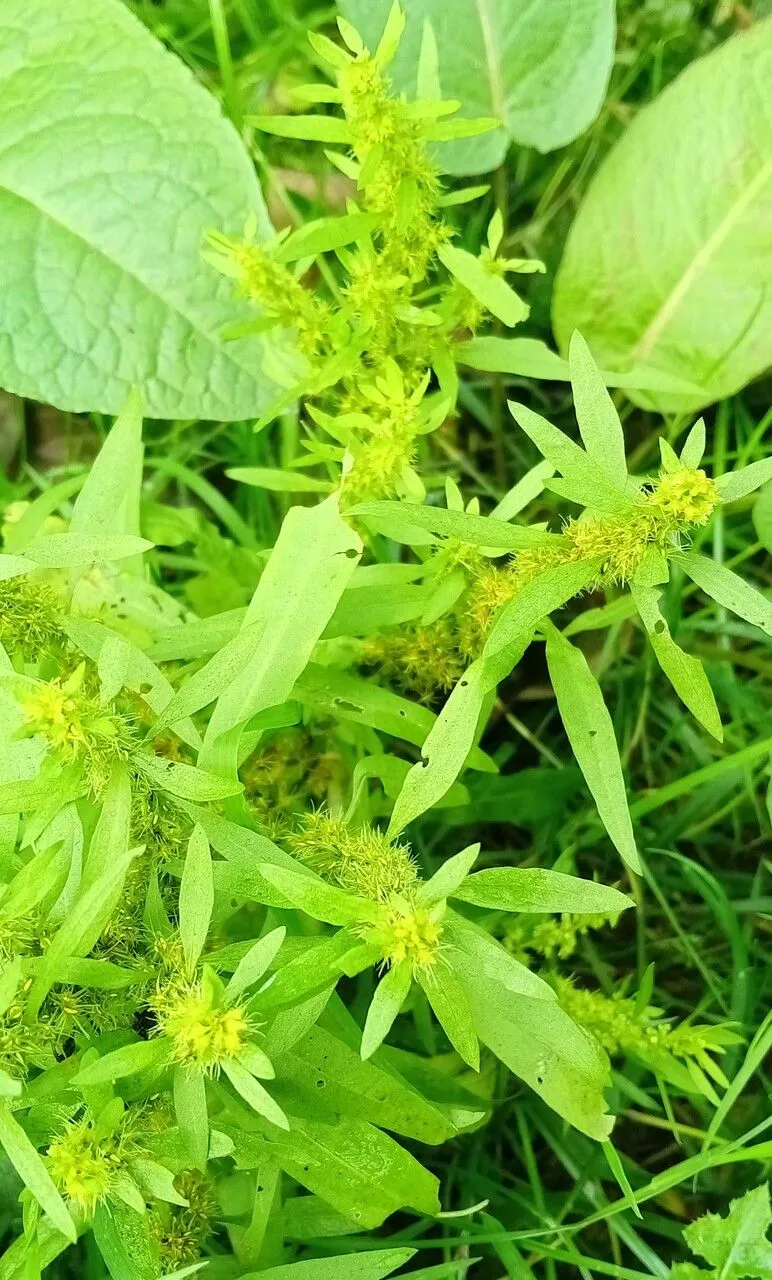
Author: L.
Bibliography: Sp. Pl.: 335 (1753)
Year: 1753
Status: accepted
Rank: species
Genus: Rumex
Vegetable: False
Observations: Subarctic & Temp. Eurasia
The Maritime dock, scientifically known as Rumex maritimus, is a fascinating plant species belonging to the Polygonaceae family. First described by the renowned botanist Carl Linnaeus in his seminal work “Species Plantarum” published in 1753, this plant has since been recognized for its distinctive characteristics and adaptability to various environments.
Rumex maritimus thrives primarily across subarctic and temperate regions of Eurasia. These habitats encompass a wide range of climatic conditions, showcasing the plant’s resilience and versatility. Maritime dock typically grows in moist, nutrient-rich soils, often found near wetlands, riverbanks, and coastal areas. Its notable ability to withstand both saline and fresh water environments highlights its remarkable adaptability.
The plant itself is relatively modest in appearance, featuring elongated leaves with a slightly wavy edge, and stems that can vary in height. One of its key identifying features is its inflorescence – a cluster of small, greenish flowers that form dense, spike-like structures. As the flowers mature, they give way to seeds that are encased in small, winged coverings, aiding in their dispersal by wind and water.
Maritime dock plays an important role in its native ecosystems, providing a food source for various insects and animals. It also contributes to the stability of soil and the prevention of erosion, particularly in vulnerable coastal and riparian zones. This ecological significance, coupled with its adaptability, makes Rumex maritimus a valuable species in maintaining environmental balance.
Beyond its ecological contributions, Maritime dock has also been of interest in traditional medicine in some cultures, where different parts of the plant have been used for their purported medicinal properties. However, such uses are based on traditional knowledge and require further scientific validation.
In summary, Rumex maritimus is a resilient and ecologically valuable plant species widely distributed across subarctic and temperate Eurasia. Its adaptability to diverse environments and its role in maintaining ecological balance underscore its importance in both natural and scientific communities.
Eng: golden dock, maritime dock, bristle dock, golden shore dock, seaside dock
Deu: strand-ampfer, strandampfer, ufer-ampfer
Dan: strand-skræppe
Nob: frynsehøymol
Nno: frynsehøymole
Nld: goudzuring
Nor: guulsyre, havsyre, liden vassyre, strandsyre
Fra: patience maritime, oseille maritime, rumex maritime
Swe: strandskräppa
Cym: tafol arfor, tafol melynion, tafolen felen, tafolen y gors, tafolen y môr
En: Maritime dock, Golden dock, BRISTLE DOCK, Golden shore dock, Seaside dock
Be: Шчаўе прыморскае
Bn: সোনালী বনপালং
Bg: Морски лапад
Zh: Ci suan mo, 連明子
Cs: Šťovík přímořský
Da: Strand-skræppe
Nl: Goudzuring
Et: Merioblikas
Fi: Keltahierakka
Fr: Patience maritime, Oseille maritime, Rumex maritime
De: Strand-Ampfer, Strandampfer, Ufer-Ampfer
He: חומעת החוף
It: Rómice marittimo
Lv: Jūrmalas skābene
Nv: Ahaditʼáán
No: Guulsyre, Havsyre, Liden vassyre, Strandsyre
Nb: Frynsehøymol
Nn: Frynsehøymole
Pl: Szczaw nadmorski
Ru: Щавель приморский
Sv: Strandskräppa
Zh-tw: 連明子
Cy: Tafolen felen, Tafol Arfor, Tafol Melynion, Tafolen y Gors, Tafolen y Môr
Taken Sep 12, 2019 by Peter V (cc-by-sa)
Taken Nov 6, 2021 by Trap Hers (cc-by-sa)
Taken Aug 5, 2020 by Michiel De Boeck (cc-by-sa)
Taken Aug 24, 2020 by Klaas Scholte (cc-by-sa)
Taken Nov 17, 2022 by Françoise Alsaker (cc-by-sa)
Taken Oct 3, 2021 by Genghis Attenborough (cc-by-sa)
Taken Aug 15, 2014 by Andrzej Konstantynowicz (cc-by-sa)
Taken Aug 15, 2014 by Andrzej Konstantynowicz (cc-by-sa)
Taken Sep 27, 2021 by April_ (cc-by-sa)
Taken Aug 15, 2014 by Andrzej Konstantynowicz (cc-by-sa)
Taken Sep 3, 2013 by Tela Botanica − Jacques Maréchal (cc-by-sa)
Taken Aug 31, 2013 by Tela Botanica − Jacques Maréchal (cc-by-sa)
Taken Oct 3, 2021 by Genghis Attenborough (cc-by-sa)
Taken Aug 15, 2014 by Andrzej Konstantynowicz (cc-by-sa)
Taken Jan 1, 1800 by Tela Botanica − Gaël GICQUIAUD (cc-by-sa)
Taken Jul 18, 2022 by #MaryKingfishers MK (cc-by-sa)
Taken Jul 21, 2022 by Alexander Baransky (cc-by-sa)
Taken May 21, 2019 by olivier Deligniere (cc-by-sa)
Taken Sep 19, 2019 by Tela Botanica − Andy Helli (cc-by-sa)
Taken Sep 15, 1999 by Photoflora – Benoit BOCK (©)
Taken Jan 1, 1970 by Photoflora – L’Abbé COSTE (©)
Taken Jul 15, 2009 by Photoflora – Benoit BOCK (©)
Taken Jan 1, 1800 by Tela Botanica − Daniel MATHIEU (cc-by-sa)
Taken Oct 3, 2021 by Genghis Attenborough (cc-by-sa)
© copyright of the Board of Trustees of the Royal Botanic Gardens, Kew.
© copyright of the Board of Trustees of the Royal Botanic Gardens, Kew.
© copyright of the Board of Trustees of the Royal Botanic Gardens, Kew.
Growth form: Rhizomatous
Growth habit: Forb/herb
Growth rate: Rapid
Ph maximum: 8.2
Ph minimum: 5.0
Light: 8
Atmospheric humidity: 8
Bloom months: [‘jul’, ‘aug’, ‘sep’, ‘oct’]
Soil nutriments: 8
Soil salinity: 1
Family: Myrtaceae Author: (F.Muell.) K.D.Hill & L.A.S.Johnson Bibliography: Telopea 6: 402 (1995) Year: 1995 Status:…
Family: Rubiaceae Author: Pierre ex A.Froehner Bibliography: Notizbl. Bot. Gart. Berlin-Dahlem 1: 237 (1897) Year:…
Family: Sapindaceae Author: Koidz. Bibliography: J. Coll. Sci. Imp. Univ. Tokyo 32(1): 38 (1911) Year:…
Family: Asteraceae Author: A.Gray Bibliography: Pacif. Railr. Rep.: 107 (1857) Year: 1857 Status: accepted Rank:…
Family: Fabaceae Author: Medik. Bibliography: Vorles. Churpfälz. Phys.-Ökon. Ges. 2: 398 (1787) Year: 1787 Status:…
Family: Aspleniaceae Author: (Cav.) Alston Bibliography: Bull. Misc. Inform. Kew 1932: 309 (1932) Year: 1932…